
Aster is a genus of perennial flowering plants in the family Asteraceae. Its circumscription has been narrowed, and it now encompasses around 170 species, all but one of which are restricted to Eurasia; many species formerly in Aster are now in other genera of the tribe Astereae. Aster amellus is the type species of the genus and the family Asteraceae.
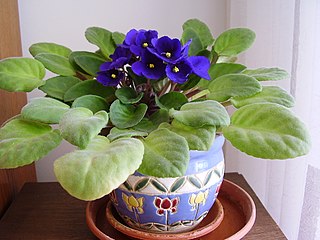
Gesneriaceae, the gesneriad family, is a family of flowering plants consisting of about 152 genera and ca. 3,540 species in the tropics and subtropics of the Old World and the New World, with a very small number extending to temperate areas. Many species have colorful and showy flowers and are cultivated as ornamental plants.

Berberis, commonly known as barberry, is a large genus of deciduous and evergreen shrubs from 1–5 m (3.3–16.4 ft) tall, found throughout temperate and subtropical regions of the world. Species diversity is greatest in South America and Asia; Europe, Africa and North America have native species as well. The best-known Berberis species is the European barberry, Berberis vulgaris, which is common in Europe, North Africa, the Middle East, and central Asia, and has been widely introduced in North America. Many of the species have spines on the shoots and all along the margins of the leaves.

Wisteria floribunda, common name Japanese wisteria, is a species of flowering plant in the family Fabaceae, native to Japan. Growing to 9 m (30 ft), Wisteria floribunda is a woody, deciduous twining climber. It was first brought from Japan to the United States in the 1830s. Since then, it has become one of the most highly romanticized flowering garden plants. It is also a common subject for bonsai, along with Wisteria sinensis.
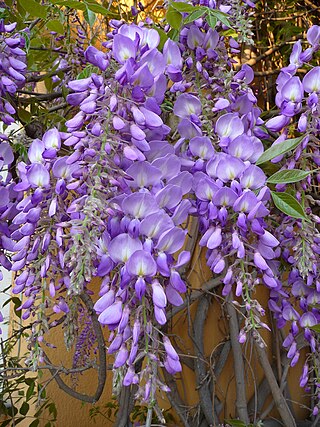
Wisteria sinensis, commonly known as the Chinese wisteria, is a species of flowering plant in the pea family, native to China, in the provinces of Guangxi, Guizhou, Hebei, Henan, Hubei, Shaanxi, and Yunnan. Growing 20–30 m (66–98 ft) tall, it is a deciduous vine. It is widely cultivated in temperate regions for its twisting stems and masses of scented flowers in hanging racemes, in spring.

Gloxinia is a genus containing three species of tropical rhizomatous herbs in the flowering plant family Gesneriaceae. The species are primarily found in the Andes of South America, but Gloxinia perennis is also found in Central America and the West Indies, where it has probably escaped from cultivation.

Streptocarpus is an Afrotropical genus of flowering plants in the family Gesneriaceae. The genus is native to Afromontane biotopes from central, eastern and southern Africa, including Madagascar and the Comoro Islands. The flowers are five-petalled, salverform tubes, almost orchid-like in appearance, and hover or arch over the plant, while the pointed, elongate fruit is of a helical form similar to that of the "tusk" of a narwhal. In the wild, species can be found growing on shaded rocky hillsides or cliffs, on the ground, in rock crevices, and almost anywhere the seed can germinate and grow. For the home, there are now many hybrids of various colours and forms available.
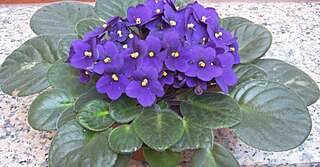
Streptocarpus sect. Saintpaulia is a section within Streptocarpus subgenus Streptocarpella consisting of about ten species of herbaceous perennial flowering plants in the family Gesneriaceae, native to Tanzania and adjacent southeastern Kenya in eastern tropical Africa. The section was previously treated as a separate genus, Saintpaulia, but molecular phylogenetic studies showed that it was nested within the genus Streptocarpus.
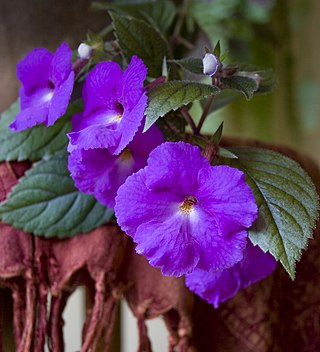
Achimenes is a genus of about 25 species of tropical and subtropical rhizomatous perennial herbs in the flowering plant family Gesneriaceae. They have a multitude of common names such as magic flowers, widow's tears, Cupid's bower, or hot water plant.

Kohleria is a New World genus of the flowering plant family Gesneriaceae. The plants are generally tropical herbs or subshrubs with velvety stems and foliage and brightly colored flowers with spots or markings in contrasting colors. They are rhizomatous and commonly include a period of dormancy in their growth cycle. The genus was revised in 1992 and was then recognized as having 19 species distributed in Central America and South America. phylogenetic in 2005 indicated that the epiphytic genus Capanea is derived from within Kohleria, and the two species of Capanea were subsequently transferred to Kohleria. The genus Pearcea is closely related.

Sinningia is a genus of flowering plants in the family Gesneriaceae. It is named after Wilhelm Sinning (1792–1874), a gardener of the Botanische Gärten der Friedrich-Wilhelms-Universität Bonn. There are about 65 species of tuberous herbaceous perennials, all occurring in Central and South America, with the greatest concentration of species occurring in southern Brazil.

Nematanthus is a genus of flowering plants in the family Gesneriaceae. All of its species are endemic to Brazil. Compared to other gesneriads, Nematanthus has leaves that are small, succulent, and hard-surfaced. The plant has a trailing, branching, and spreading habit; it is generally an epiphyte in nature and a hanging-basket plant in cultivation. The flower has fused petals. In some species, the flower has a "pouch" at the bottom. The fancied resemblance of such flowers to a goldfish gives these plants the common name goldfish plant or guppy plant.

Miscanthus sinensis, the eulalia or Chinese silver grass, is a species of flowering plant in the grass family Poaceae, native to eastern Asia throughout most of China, Japan, Taiwan and Korea.

Acer palmatum, commonly known as Japanese maple, palmate maple, or smooth Japanese maple (Korean: danpungnamu, 단풍나무, Japanese: irohamomiji, イロハモミジ, or momiji,, is a species of woody plant native to Korea, Japan, China, eastern Mongolia, and southeast Russia. Many different cultivars of this maple have been selected and they are grown worldwide for their large variety of attractive forms, leaf shapes, and spectacular colors.

Primulina is a genus of flowering plants in the African violet family Gesneriaceae. In 2011 the genus was expanded with the transfer of many species that had previously been placed in the genus Chirita. In 2016, five species were moved to the genus Deinostigma.
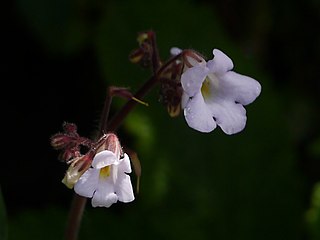
Henckelia is a genus of flowering plants in the family Gesneriaceae. Many of its species were formerly placed in Didymocarpus sect. Orthoboea and in the genus Chirita. Many species formerly placed in Henckelia have been moved to Codonoboea and Loxocarpus.
Primulina swinglei is a species of plants in the family Gesneriaceae. It is found in China and Vietnam.

Sarmienta scandens, the Chilean pitcher flower, is a species of flowering plant, and the sole member of its genus within the family Gesneriaceae. It is native to the cool South Chilean rainforest, where it grows as an epiphyte.

The Didymocarpoideae are a subfamily of plants in the family Gesneriaceae. It was formerly the subfamily Cyrtandroideae. This subfamily consists mostly of tropical and subtropical Old World genera, found in Africa, Asia and the Pacific. One species is native to Central and South America.

Primulina dryas, called the oak-nymph-leaved primulina, is a species of flowering plant in the genus Primulina, native to southeast China. It has gained the Royal Horticultural Society's Award of Garden Merit.



















